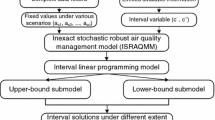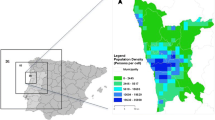Abstract
The issue of air pollution has become the focus of the world because of its significant influence to the economic development and public health. This paper proposes an interval dual stochastic-mixed integer programming (IDSIP) approach for regional air quality management. The IDSIP approach can be effectively communicated into the optimization processes and resulting solutions, which is formulated through integrating interval-parameter integer programming (IIP) within a two-stage stochastic programming (TSP) joint chance-constrained programming (CCP) and could deal with uncertainties expressed as not only probability distributions but also interval values. Moreover, the left-hand-side (LHS) constraints with stochastic variables could be handled at different risk levels with varied reliability scenarios. In the modeling formulation, penalties are imposed when expected policies are violated. The results indicate that reasonable solutions for air quality management system have been generated, which can help decision makers draw up productive strategies taking into account the trade-off between system economy and air quality under uncertainty.








Similar content being viewed by others
References
Albornoz, V. M., Benario, P., & Rojas, M. E. (2004). A two-stage stochastic integer programming model for a thermal power system expansion. International Transactions in Operational Research, 11(3), 243–257.
Bean, J. C., Higle, J. L., & Smith, R. L. (1992). Capacity expansion under stochastic demands. Operations Research, 40(3), 210–216.
Berman, O., & Ganz, Z. (1994). The capacity expansion problem in the service industry. Computers & Operations Research, 21(5), 557–572.
Birge, J. R., & Louveaux, F. V. (1997). Introduction to stochastic programming. New York: Springer.
Boubel, R. W., Fox, D. L., Turner, D. B., & Stern, A. C. (1994). Fundamentals of air pollution (3rd ed.). San Diego: Academic Press.
Cao, M. F., Huang, G. H., & He, L. (2011). An approach to interval programming problems with left-hand-side stochastic coefficients: an application to environmental decisions analysis. Expert Systems with Applications, 38(9), 11538–11546.
Chan, C. K., & Yao, X. (2008). Air pollution in mega cities in China. Atmospheric Environment, 42(1), 1–42.
Chang, S. Y., & Kashani, F. R. (2009). Linear programming method for investigating the disposal histories and locations of pollutant sources in an aquifer. Journal of Environmental Informatics, 13(1), 1–11.
Chen, M. J., & Huang, G. H. (2001). A derivative algorithm for inexact quadratic program—application to environmental decision-making under uncertainty. European Journal of Operational Research, 128(3), 570–586.
Eppen, G. D., Martin, R. K., & Schrage, L. (1989). A scenario approach to capacity planning. Operations Research, 37(4), 517–527.
Flagan, R. C., & Seinfeld, J. H. (1988). Fundamentals of air pollution engineering. Englewood Cliffs: Prentice-Hall.
Huang, G. H. (1998). A hybrid inexact-stochastic water management model. European Journal of Operational Research, 107(1), 137–158.
Huang, G. H., & Loucks, D. P. (2000). An inexact two-stage stochastic programming model for water resources management under uncertainty. Civil Engineering and Environmental Systems, 17(2), 95–118.
Huang, G. H., Baetz, B. W., & Patry, G. G. (1995a). Grey quadratic programming and its application to municipal waste management planning under uncertainty. Engineering Optimization, 23(3), 210–223.
Huang, G. H., Baetz, B. W., & Patry, G. G. (1995b). Grey fuzzy integer programming: an application to regional waste management planning under uncertainty. Socio-Economic Planning Science, 29(3), 17–38.
Huang, G. H., Cohen, S. J., & Yin, Y. Y. (1996). Incorporation of inexact dynamic optimization with fuzzy relation analysis for integrated climate change impact study. Journal of Environmental Management, 48(1), 45–68.
Huang, G. H., Li, Y. P., Xiao, H. N., & Qin, X. S. (2007). An inexact two-stage quadratic program for water resources planning. Journal of Environmental Informatics, 10(2), 99–105.
Li, Y. P., & Huang, G. H. (2006). An inexact two-stage mixed integer linear programming method for solid waste management in the city of Regina. Journal of Environmental Management, 81(3), 188–209.
Li, Y. P., Huang, G. H., Nie, S. L., & Qin, X. S. (2007). An inexact two-stage chance-constrained program for planning waste management systems. Resources, Conservation and Recycling, 49(3), 284–307.
Liu, L., Huang, G. H., Liu, Y., & Fuller, G. A. (2003). A fuzzy-stochastic robust optimization model for regional air quality management under uncertainty. Engineering Optimization, 35(2), 177–199.
Loucks, D. P., Stedinger, J. R., & Haith, D. A. (1981). Water resource systems planning and analysis. Englewood Cliffs: Prentice-Hall.
Lu, H. W., Huang, G. H., & He, L. (2010). A two-phase optimization model based on inexact air dispersion simulation for regional air quality control. Water, Air, & Soil Pollution, 211(1–4), 121–134.
Luo, B., Maqood, I., Huang, G. H., Yin, Y. Y., & Han, D. J. (2005). An inexact fuzzy two-stage stochastic model for quantifying the efficiency of nonpoint source effluent trading under uncertainty. Science of Total Environment, 347(1), 21–34.
Lv, Y., Huang, G. H., Li, Y. P., Yang, Z. F., & Sun, W. (2012). Development of a sequential decision-making model for controlling multiple air pollutants under stochastic uncertainty. Water, Air, & Soil Pollution, 223(1), 443–465.
Nernirovski, A. (2012). On safe tractable approximations of chance constraints. European Journal of Operational Research, 219(3), 707–718.
Pasquill, F. (1974). Atmospheric diffusion (2nd ed.). New York: Halstead Press.
Qin, X. S., & Huang, G. H. (2009). An inexact chance-constrained quadratic programming model for stream water quality management. Water Resources Management, 23(4), 661–695.
Rose, C., & Smith, M. D. (1996). The multivariate normal distribution. Mathematica Journal, 6, 32–37.
Rose, C., & Smith, M. D. (2002). Mathematical statistics with mathematica. New York: Springer.
Seinfeld, J., & Pandis, S. (1998). Atmospheric chemistry and physics. New York: John Wiley & Sons.
Swaminathan, J. M. (2000). Tool capacity planning for semiconductor fabrication facilities under demand uncertainty. European Journal of Operational Research, 120(3), 545–558.
Tong, L. (1990). The multivariate normal distribution. New York: Springer.
Wang, S., & Huang, G. H. (2013). Interactive fuzzy boundary interval programming for air quality management under uncertainty. Water, Air, & Soil Pollution, 224(5), 1–16.
Wang, T. J., Jiang, F., Li, S., & Liu, Q. (2007). Trends in air pollution during 1996–2003 and cross-border transport in city clusters over the Yangtze River Delta region of China. Terrestrial, Atmospheric and Oceanic Sciences, 18(5), 995–1009.
Yeomans, J. S. (2008). Applications of simulation–optimization methods in environmental policy planning under uncertainty. Journal of Environmental Informatics, 12(2), 174–186.
Zare, Y., & Daneshmand, A. (1995). A linear-approximation method for solving a special-class of the chance-constrained programming problem. European Journal of Operational Research, 80(1), 213–225.
Acknowledgments
This research was supported by the Key Project of the Ministry of Education (no. 311013). The authors thank the anonymous reviewers for their comments and suggestions that helped in improving the manuscript.
Author information
Authors and Affiliations
Corresponding author
Appendix
Appendix
1.1 Left-Hand-Side Chance-Constrained Programming
In general, the CCP method can be used for dealing with uncertainties expressed as stochastic variables in the right hand (Loucks et al. 1981; Huang 1998; Li et al. 2007). However, parameters in the LHS of the constraints are stochastic variables frequently. The method of left-hand stochastic (LHS) will be illustrated as follows (Cao et al. 2011):
The left-hand stochastic of model can be formulated as follows:
subject to:
…
…
where ξ ij (i = 1, 2, …, l and j = 1, 2, …, n) are stochastic variables, and c ± ij , a ± ij , and b ± i are interval numbers. Constraints of model (1) contain stochastic variables and can be violated with a low probability (p i ≤ 0.5). In other words, the probability of satisfying the constraints cannot be less than 1 − p i .
Then, suppose that the constraints are independent with each other, and all the parameters (c ± ij ) in the objective function are not <0. Suppose that ξ = (ξ i1, ξ i2, …, ξ in )T obeys an n-dimensional normal distribution:
where μ = (a i1, a i2, …, a in )T is the expectation of ξ and V = (v ij ) n × n is the variance–covariance matrix of n. Parameters in the LHS of the constraints are positive in most of practical problems; thus, without loss of generality, we suppose that the expectation of ξ is positive, i.e., μ ≥ 0.
Since ξ obeys an n-dimensional normal distribution, the arbitrary linear combinations of its elements obey one-dimensional normal distribution (Tong 1990; Rose and Smith 1996, 2002). Thus, we have:
where d = (d 1, d 2, …, d n )T ∈ R n. Let
then Ω is a set of stochastic variables which obeys a one-dimensional normal distribution. Since each x ± ij (1 ≤ i ≤ l, 1 ≤ j ≤ n) is an interval containing a set of deterministic numbers, there are infinite linear combinations of ξ i1, ξ i2, …, ξ in . In other words, there are infinite stochastic variables within Ω.
For any given y j ∈ x ± j (j = 1, 2, …, n), let Y = (y 1, y 2, …, y n )T.Then, we have:
According to (10), we have:
The stochastic variable (Y T ξ) obeys a one-dimensional normal distribution whose exception is Y T μ and variance is Y T VY. Then Y T ξ can be expressed as follows:
where Z ∼ N(0, 1).
Theorem 1
Constraint \( {P}_r\left\{{\xi}_{i1}{x}_1^{\pm }+\cdots +{\xi}_{in}{x}_n^{\pm}\tilde{\le}{b}_i^{\pm}\right\}\ge 1-{p}_i \) can be converted to the following inequalities:
or
From (9), we have \( \mu +{Z}^{\left(1-{p}_i\right)}\sqrt{D_i(V)}={\left({a}_{ij}+{Z}^{\left(1-{p}_i\right)}\sqrt{v_{ij}}\right)}_{n\times 1} \).
Therefore, constraints (15a), (15b), (16a), and (16b) can be converted to:
or
Rights and permissions
About this article
Cite this article
Zhen, J., Li, W., Huang, G. et al. An Air Quality Management Model Based on an Interval Dual Stochastic-Mixed Integer Programming. Water Air Soil Pollut 225, 1986 (2014). https://doi.org/10.1007/s11270-014-1986-x
Received:
Accepted:
Published:
DOI: https://doi.org/10.1007/s11270-014-1986-x




